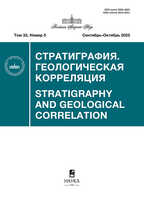Стратиграфия
Рецензируемый научный журнал
- Издатель: Российская академия наук
- Год основания: 1993
- Рубрика (ГРНТИ): 38.29.00 Стратиграфия
- Главный редактор: академик РАН Михаил Александрович Семихатов
- Периодичность: 6 выпусков в год
Присутствие в базах данных:
Описание журнала:
Целью журнала Стратиграфия, геологическая корреляция является всестороннее освещение фундаментальных и прикладных аспектов стратиграфии и корреляции геологических событий и процессов во времени и пространстве. Публикуемые статьи основаны на результатах комплексных исследований и предназначены для ученых, профессоров университетов, студентов и геологов, интересующихся стратиграфией и хронологией того, что сохранилось в геологической летописи Земли.
Журнал является рецензируемым и включен в Перечень ВАК для опубликования работ соискателей ученых степеней. С 2010 г. входит в систему РИНЦ.
|
С 2020 года размещение выпусков журнала и прием рукописей от авторов осуществляются на сайте другого издательства.
|
|
From 2020 the journal transfered to the new web-site also with the article submission system.
|
最新一期
卷 33, 编号 5 (2025)
Articles
The Age of the Devonian Barzas Formation of the Kuznetsk Coal Basin Based on Palynological Data
摘要
 3-14
3-14


Basal horizons of the sedimentary cover of the Stoilensky iron ore deposit (Belgorod region, Russia): their age, palaeontological characteristics and conditions of their formation
摘要
 15-36
15-36


New Data on the Lower Permian Kushtau Reef Massif, Southern Urals: Biostratigraphy and Lithofacies
摘要
 37-71
37-71


U–Th–Pb (LA-ICP-MS) dating of detrital zircons from Jurassic deposits of the Franz Josef Land archipelago (Russian Arctic) and the evolution of their provenance
摘要
 72-92
72-92


Sedimentary environments, biota and stratigraphy of the Bajocian–Oxfordian of the northern wing of the Chekurovskaya anticline (Lower Lena River, northern East Siberia)
摘要
 93-134
93-134











